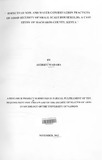| dc.description.abstract | The economic performance and development prospects of many developing countries like Kenya are largely dependent on cash crop production. The heavy dependence of these developing countries on agricultural commodities exposes them to adverse economic impacts, sometimes with harmful consequences for growth and the reduction of poverty (Doppler, 2004). The study covered Muisuni are in Kangundo, Machakos district in a quest to establish the effects of soil and water conservation practices of food security. The study had a response rate of 52 per cent where 57.7 percent (i.e. 30) respondents were male and 42.3 percent (22) were female. 61.5 percent were of secondary & above education levels, as expected, 71.2 percent were elderly with 41 years arid above and the majority 90.4 percent was married.
The study was looking at answering its research questi of a) to establish how farmers in the study area are exposed to agricultural extension educative efforts; b) to establish the level of food security among the households sampled; c) to examine the characteristics of the households sampled; d) to find out the types of soil and water conservation practices recommended and used and finally e) their level of adoption by households. The study mainly used frequency tables on every variable to try and look at the significance in relationship between the independent variable and the dependent variable in our case being food security. This study focused on water and soil conservation to impact on the food production (maize) and security in developing countries Was a modest attempt to bridge the knowledge gap on the various ways to deal with rain water sources, reduce soil degradation and increase food production.
From the multivariate level, there were 5 household characteristics variables in the model, the model showed a weak relationship where 37.98 percent of the variation in food security is accounted for by the independent variables in the model. From the results as well, age was seen as having the highest strength in variation as compared to the other four independent variable, meaning that for the age variable, we would expect an increase of 20.95 percent in the food security variable score for every one unit increase in age value assuming that all the other variables in the model are held constant. According to the model, it also shows that gender has a highly negative variation to the dependent variable food security.
The study therefore concluded that Age is a very important factor to food security as amongst others, it show that the respondents are well exposed to information and are conclusively aware of what to expect and where to go to in cases of agricultural deficiencies. The study recommended further research to food security as food security does not only focus on crop yield. The study therefore recommends further conclusive research be done to combine the various components of food security in order to get the conclusive impact of independent variables to food security. Early warning systems should be put in place in order to assist the farmers plan and have knowledge on what decisions to make on their farming practices. Partnering with the private sector should also be encouraged this will facilitate sharing of information. | en_US |

